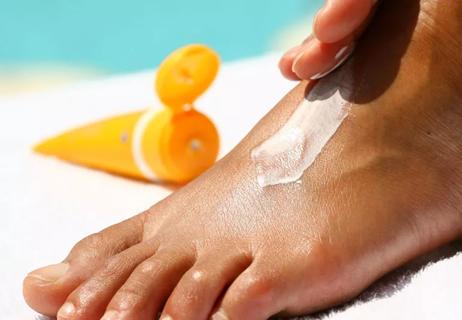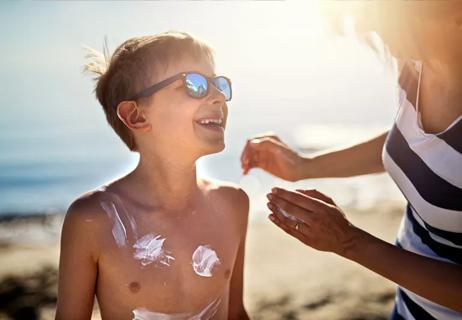Research shows that umbrella shade is less effective than sunscreen for preventing sunburn

Who needs sunscreen if you’re sitting under a big beach umbrella? Skin-scorching ultraviolet (UV) rays beaming down from the sun can’t possibly turn you red if you’re lounging under cover, right?
Advertisement
Cleveland Clinic is a non-profit academic medical center. Advertising on our site helps support our mission. We do not endorse non-Cleveland Clinic products or services. Policy
Well, if you believe that, you’re in the dark in more ways than one.
The shade of a beach umbrella provides far less effective sun protection than a sunscreen with a high sun protection factor (SPF), research shows. In fact, the odds say that under-the-umbrella loungers leave the beach with a sunburn.
So, let’s look at your best options to protect your skin from the sun with the help of dermatologist Amy Kassouf, MD.
Sunscreen is your best bet to limit damage from the sun’s intense rays, says Dr. Kassouf.
It’s important to use the right kind of sunscreen to get the job done. A broad-spectrum sunscreen is most effective, as it protects you against UVA and UVB rays, the two types of sun rays that damage the body.
UVA and UVB rays can contribute to:
A higher SPF number offers more protection against UVB rays, the main cause of sunburn. Dr. Kassouf recommends using sunscreen with an SPF of at least 30.
Putting on sunscreen isn’t a one-and-done process, either. Be sure to reapply every two to three hours when you’re out in the sun — and more frequently if you’re perspiring, advises Dr. Kassouf. It’s best to redo your sunscreen after swimming, too.
Advertisement
Try not to be stingy with the amount of sunscreen you use. If you’re wearing a swimsuit, you should apply about an ounce of sunscreen at a time. (That’s about as much as would fill a shot glass.)
“If you don’t apply as much as you should, it limits the protection the sunscreen offers,” says Dr. Kassouf. “Some people are lucky to get the protection of an SPF 15 out of an SPF 30 because they’re not using enough.”
Make sure to get that sunscreen everywhere the sun shines, too. People frequently overlook certain areas of their bodies, including their ears and feet.
If you’re heading somewhere warm and sunny from a cold-temperature climate, be aware that your skin has less built-in protection from the sun. That’s especially true during winter’s bundled-up months.
If that describes you, Dr. Kassouf suggests liberally applying and re-applying sunscreen to avoid getting scorched after hitting your vacation destination.
Shade is better than no shade when it comes to protection from the sun, but don’t expect a beach umbrella to keep you from getting sunburned.
In fact, in the study mentioned above, 78% of umbrella users ended up with sunburn after three and a half hours on the beach. For comparison sake, 25% of those using an SPF 100 sunscreen got sunburned in the same timeframe.
“It’s safe to say the protection from a beach umbrella seems to be far less than what most people would think,” Dr. Kassouf notes.
The sun can be unrelenting, as anyone who has spent hours beneath its glare knows. Your best bet? Combine sun protection options. Use a broad-spectrum sunscreen and a beach umbrella, for instance.
Wearing sun-protective clothing can add another layer of protection, says Dr. Kassouf. These garments are made from a special fabric with a tight weave that forms a barrier against the sun’s damaging rays.
SPF shirts, leggings and hats offer protection while not requiring reapplication (such as with sunscreen) or keeping you in one spot (like under an umbrella).
“You have options when it comes to protecting your skin from sun damage,” says Dr. Kassouf. “You don’t have to pick just one, either. If you use them all, in fact, they can help protect you better.”
Advertisement
Learn more about our editorial process.
Advertisement

Polarized lenses have an added benefit of a special coating that reduces glare on reflective surfaces like water and snow

Even on cloudy days or simply running errands, sunscreen is a must

Having darker skin tones doesn’t automatically offer protection from the sun

It’s easy to forget your ears, eyelids, lips and feet — but any exposed skin needs protection

More than just fashionable, the lenses reflect or block harmful UV rays and can reduce glare

Choose lotion-based options that contain titanium dioxide or zinc oxide

SPF makeup offers some protection, but you’re better off pairing it with sunscreen

An expert weighs in on sunscreen ingredients, application tips and more

Type 2 diabetes isn’t inevitable with these dietary changes

Applying a hot or cold compress can help with pain